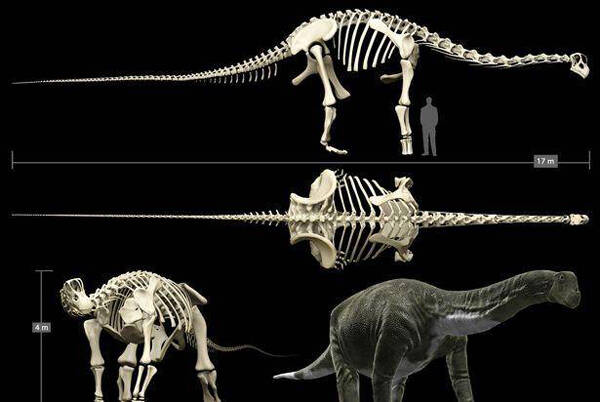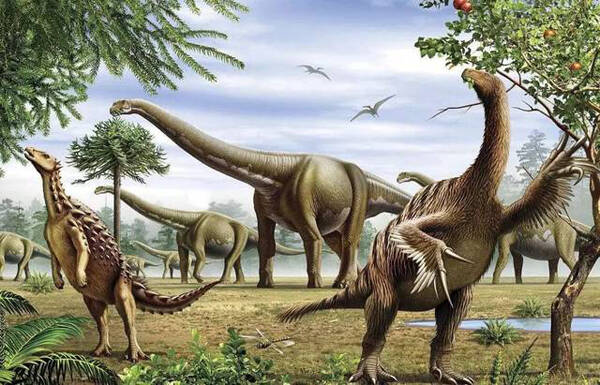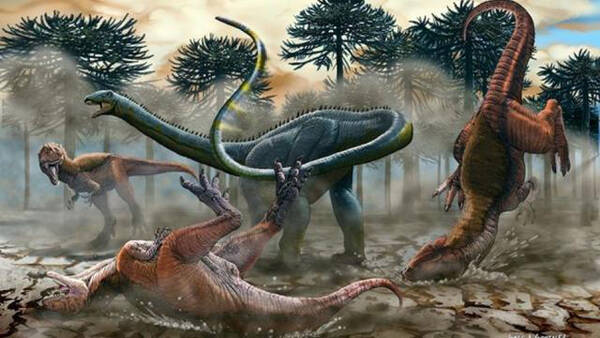In a natural history museum in Argentina, a dinosaur vertebra is on display. It is 1.6 meters long and requires a forklift to lift it, but if it were a human vertebra, one of your palms would be enough to lift it.

1. Dinosaurs are the largest land animals
This vertebra belongs to Argentinosaurus. This dinosaur lived about 100 million years ago and is, as far as we know, the largest land animal in history. During its lifetime, it can grow to about 35 meters and weigh 80 tons.
Argentinosaurus is a type of sauropod dinosaur that also includes Diplodocus, Brachiosaurus and Brontosaurus. Sauropods are easily identifiable by their long neck, long tail, barrel-shaped torso and thick legs. While not all sauropods were behemoths, the big ones were incredibly large.
No land animal has ever come close to being as big as Argentinosaurus. The largest terrestrial animal living on earth today is the African elephant, with male African Elephants-Are-Endangered.html">elephants generally weighing up to 6 tons. The largest terrestrial mammal to date is the 6-meter-tall giant rhinoceros, which lived 30 million years ago and weighed 15 tons. But none of them can compare with sauropods. Even among dinosaurs, sauropods can be regarded as the "giants". An adult Tyrannosaurus rex weighed only 7 tons. The largest non-sauropod dinosaur unearthed so far is a hadrosaurus, weighing 16 tons.
The unheard-of size of sauropods has long been a mystery to biologists. How can they grow so big? Why did no other land animal before or after this reach their size? There has been no convincing explanation for these problems.
But now, a theory can finally satisfactorily explain how they evolved.

2. Egg laying helps dinosaurs challenge their limits
As early as the 19th century, British paleontologist Edward Cobb noticed a phenomenon: animals of a species tend to become larger and larger during the evolution process. This became known as Cobb's rule.
Evolutionarily speaking, the larger the individual, the more difficult it is to be invaded by predators, and it is easier to defeat rivals when looking for food and mates, but it also brings some disadvantages. Large animals are more likely to become extinct because they eat more and reproduce more slowly than small animals. Therefore, in times of food shortage, the probability of extinction is higher.
So, on the one hand, natural selection encourages animals to grow bigger and bigger, but on the other hand, they eventually pay the price. These two forces restrict each other, so that most land animals generally do not weigh more than 10 tons.
Large size also creates other problems. For example, how to support such a heavy weight? How to get enough food and oxygen? How to prevent your body from overheating? But surprisingly, the challenges posed by these problems were all overcome by sauropods.
How is this going? In the 1990s, an American paleontologist proposed the idea that an important factor was the way sauropods reproduced. Like all dinosaurs, they were egg-laying, while almost all mammals are viviparous.
We know that the larger a mammal is, the fewer babies it has and the longer the intervals between pregnancies. However, because they lay eggs, large dinosaurs could continue to lay clutches of eggs, so they had many offspring. Elephants only give birth every four years. In the same period of time, a large dinosaur can probably lay hundreds of eggs. As dinosaurs grew in size, the number of their descendants did not decrease. In this way, they avoid the risk of general extinction of large animals due to slow reproduction. In the event of danger, their populations recover faster than those of larger mammals.
Evidence for the reproductive capabilities of sauropods comes from the extremely detailed fossil record they left behind. Sauropods left behind many fossils of eggs and nests. These dinosaur eggs are generally only the size of ostrich eggs, and a clutch can reach eight. Sometimes even the embryonic fossils inside are completely preserved.
What impressed paleontologists is that the adult sauropods were so huge, yet the eggs they laid were so small. This is really disproportionate! Usually, a large part of the energy of an individual animal is used to reproduce offspring. However, a female sauropod dinosaur must weigh at least more than 5 tons. The eggs she lays at one time do not exceed 24 kilograms at most, so she should be able to lay several clutches in a year. Egg. In addition, there is evidence that sauropods did not have the habit of caring for dinosaur eggs and baby dinosaurs, which further improved their reproductive capabilities.

3. Dinosaurs breathed like birds
But laying eggs and not needing parental care seems not to be the whole story, because all dinosaurs lay eggs, and they rarely take care of their offspring, but some are smaller, so there may be other sauropods that can grow so big. reason.
In order to become that big, it has to grow fast in its limited lifespan. To understand how fast dinosaurs grew, scientists examined slices of their bones under a microscope. Most dinosaurs have growth lines like tree rings in their bones, which are unique to animals with slow metabolisms. Sauropods, on the other hand, have no growth lines, similar to mammals and birds. This shows that sauropods have a fast metabolic rate, which allows them to reach the limit of their body size in a shorter time. For example, paleontologists' research on an Asian sauropod dinosaur weighing more than 30 tons shows that this dinosaur grew 2 tons a year, while African Elephants-Are-Endangered.html">elephants only gained 200 kilograms in weight a year.
However, a fast metabolism will inevitably cause a series of problems such as how to obtain enough oxygen and how to dissipate heat. How is this solved? Some scholars believe the secret lies in the unique body structure of sauropods.
In 2003, an American scholar pointed out that sauropod dinosaurs had a respiratory system similar to that of birds. Birds breathe more efficiently than mammals because they not only have lungs but also air sacs. When they inhale, air fills both their lungs and the air sacs in their bodies. When exhaling, although the air in the lungs flows out, fresh air flowing out from the air sacs enters the lungs at the same time (there is no fresh air in the lungs when we exhale). Therefore, their lungs are always filled with fresh air. It is calculated that in one breath, the capillaries in the lungs of birds can inhale 2.5 times as much oxygen as mammals with the same lung capacity. There is evidence that sauropods also had bird-like air sacs.
This type of breathing can also help support a large body in many ways. First, it solves the problem of how to obtain enough oxygen; second, the air sacs are located near the vertebrae in their bodies, like soft sponges, greatly reducing the pressure on the vertebrae; in addition, in order to adapt to this breathing method , there are many hollow air sac cavities in the vertebrae of sauropod dinosaurs, which reduces the weight of the vertebrae; finally, this breathing method can also facilitate heat dissipation through panting, thus solving the heat dissipation problem.

4. Tips for eating dinosaurs
The largest land animals on Earth today are herbivores, surviving by eating large amounts of leaves and grasses that have little nutritional value. This is because there are not enough nutritious foods such as fruits and seeds on land to satisfy the appetite of a giant, but there are all kinds of grass, leaves and branches. There should be no exception for those extinct giant animals.
But living on low-nutrient forages means eating a lot. The ability to eat enough to meet body needs within a limited time is an important factor in determining an animal's size. An elephant needs to spend 18 hours a day eating non-stop and can eat about 200 kilograms of plants a day.
Large sauropods needed to eat about 1 ton of plants a day. How could they do this? Paleontologists believe their long, crane-like necks and small heads hold the key to understanding the problem.
As mentioned earlier, sauropod vertebrae were lighter because they were hollow, which allowed their necks to grow longer. As a result, their eating range is wider, up, down, left and right. They can stand still and do it all by twisting their necks while reducing energy loss.
And when eating, they don't chew. Instead, they use their teeth to collect leaves and branches, fill their mouths, and then swallow them all. Doing so allows them to cram more food into their bellies each day than if they spent time chewing. It also means they don't need bulky molars and the accompanying musculature.This reduces the weight of the head and allows the neck to be stretched longer.
The nutrients obtained from an unchewed meal require a long period of fermentation by microorganisms in the body before they can be absorbed. But this creates a new problem: Since flowering plants have not yet evolved in the era when sauropods dominated the earth, their diet is limited to relatively primitive gymnosperms such as fir trees, ginkgo and masson pine. According to animal nutritionists in the past, the nutritional value of this type of feed was particularly low. So how could sauropods survive on these plants?
To this end, in 2008, a German paleontologist extracted and cultured microorganisms from the digestive tract of sheep, and then fed these primitive plants as food to simulate the digestion of dinosaurs. It turns out these plants are far more nutritious than once thought. Just give these primitive plants long enough and they will be digested and assimilated quite thoroughly. Therefore, it can be speculated that the food eaten by sauropod dinosaurs must have stayed in their bodies for a long time.
Through their unique reproductive, physical and lifestyle advantages, sauropods finally overcame the disadvantages that restricted the growth of other land animals and grew into unprecedented giants. They survived for 145 million years before becoming extinct 65 million years ago.
animal tags: dinosaur argentinosaurus sauropod oviparous predator reproduction
We created this article in conjunction with AI technology, then made sure it was fact-checked and edited by a Animals Top editor.